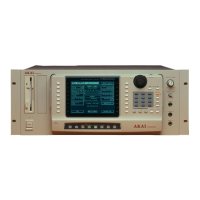24 Version 1.21
STRUCTURE
s5000
/
s6000
Keygroups can also overlap:
KEYGROUP 1 KEYGROUP 2
A program with two overlapping keygroups with a crossfade
In this case, when keygroups overlap, a crossfade is automatically applied to make the transition
smooth.
You can also layer keygroups:
KG1 KG2 KG3 KG4 KG5
KG6 KG7 KG8 KG9 KG1 0
KG1 KG2 KG3 KG4 KG5
KG 6
KG1 KG2 KG3 KG4 KG5
KG 6 KG7
Some examples of layered keygroups
Although layering keygroups in this way is excellent for creating rich textures, you may find it
easier to layer sounds in the multi simply by assigning the appropriate sounds to parts and playing
them all on the same MIDI channel.
Each keygroup has four ZONES where samples may be layered on top of each other and/or
switched between using velocity.
Different programs may share samples (for example, you could use the same kick and snare drum
in a variety of different drum programs).
As well as mapping samples/keygroups across the keyboard range, programs also allow you to
apply envelope shaping, filtering, LFO modulation (vibrato, etc.) and much more and such is the
flexibility of the program’s sound shaping functions that the S6000 can be used as a very powerful
synthesiser as well.

